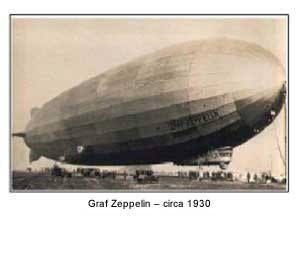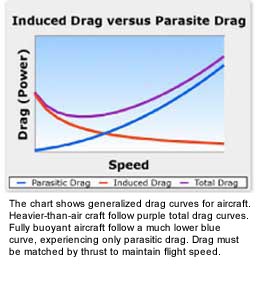
|
ENVIRONMENTAL IMPACT [ print version ] Operational Efficiency
Emissions & Energy Intensity Green House Gas (GHG) emissions in the transportation sector are directly linked to the energy intensity of the vehicle, with approximately 99% of the GHG emissions in the form of CO2. As shown in the chart below, short-haul jet aircraft use the most energy, followed by long haul jets. Trucks are next, with ship and rail significantly less. The future technology of skyships is remarkably promising. On the drawing board are advanced engineered skyships designed to use less than 1% of the energy of short-haul jet aircraft. The skyships will be operating at speeds of 100 kph. In comparison, skyships will decrease by 89% the energy use of long haul jet aircraft while operating at speeds of 140 kph. A transition from the highest intensity modes of transportation to lower intensity modes will therefore reduce the carbon footprint significantly. Transition from trucking can reduce energy consumption and associated emissions by 75%. This will simultaneously reduce the impact on roadway infrastructure and will enable service to pristine areas without the need to build expensive and intrusive roads.   Based on direct mass and distance comparisons, the energy intensity for a skyship is highly dependent upon its speed. In the first comparison with ship and rail transportation modalities, skyships are competitive in operational efficiencies. Marine ship speeds average 55 kph and freight rail averages 35 kph due to crossings, grades, and other interruptions. Advanced technology skyships will be able to maintain average speeds of 140 kph. This will enable moving timesensitive goods and provide significant energy utilization reductions over jet airfreight and trucks. If carbon caps are a significant economic driver, then slower skyships speeds of 100 kph will outperform both ship and rail. For ecotourism sightseeing flights, speeds will often be 50 kph or slower, dramatically lowering both fuel consumption and the carbon footprint of travelers. The direct skyship route will significantly decrease the energy expenditure over rail lines, sea-lanes, ports, or roads. The actual distance from origin to destination will usually be between 10% and 50% less than for other modes. Lengthy multimodal transits will be reduced or eliminated, i.e. trucking to a port, loading onto a ship, traversing a circuitous sea-lane around a coast, transfer to rail cars and travel along grade-constrained tracks, off-loading to a truck, following congested roadways, eventually arriving at the destination. Compared to point-to-point delivery via a skyship, the environmental benefits will clearly be comprehensively greater than just a point-to-point mass distance energy comparison. The World Air League is committed to providing the leadership for developing environmentally sustainable lighter-than-air transportation with the lowest carbon footprint achievable. Related Links Environmental Impact in PDF Form World Sky Race Program in PDF Form
|
 Buoyant Flight is an inherently efficient form of transportation. This is the main reason why skyships were so promising in the 1920s when airplanes still seemed a speculative venture. While today they are forgotten by many, skyships were actually very successful. By 1937, commercial passenger skyships of the Deutsche Zeppelin Reederei (DZR) had flown over half a million passenger-hours and a total of 52 million passenger-km safely on regional, transoceanic, transcontinental and artic voyages. All of this was accomplished using then state-of-the-art technology that by today's standards would be considered quite primitive. The lifting gas used, flammable hydrogen, was contained within large cells made from the membranes of cow intestines. The hull was covered in a doped cotton canvas, and control systems were operated manually by a large crew. Nevertheless, due to their efficiency, skyships still did perform astounding feats and set records for aerial transportation.
Buoyant Flight is an inherently efficient form of transportation. This is the main reason why skyships were so promising in the 1920s when airplanes still seemed a speculative venture. While today they are forgotten by many, skyships were actually very successful. By 1937, commercial passenger skyships of the Deutsche Zeppelin Reederei (DZR) had flown over half a million passenger-hours and a total of 52 million passenger-km safely on regional, transoceanic, transcontinental and artic voyages. All of this was accomplished using then state-of-the-art technology that by today's standards would be considered quite primitive. The lifting gas used, flammable hydrogen, was contained within large cells made from the membranes of cow intestines. The hull was covered in a doped cotton canvas, and control systems were operated manually by a large crew. Nevertheless, due to their efficiency, skyships still did perform astounding feats and set records for aerial transportation. Skyships are so named because they float. Instead of floating on a sea of water, skyships ride in a sea of air. While marine ships must part the waves, skyships merely part the air, which is a decidedly less viscous medium. The energy expended to accomplish this task is therefore considerably smaller. Furthermore, unlike heavier-than-air craft, the lift for skyships is obtained primarily through displacement, and not aerodynamic lift. This is significant because when aerodynamic lift is produced, drag is unavoidably induced. So while both skyships and airplanes must overcome parasitic drag, airplanes must also expend a significant amount of energy to overcome induced drag. This extra drag in an airplane is greatest at lower speeds, whereas skyships are at their most efficient operations.
Skyships are so named because they float. Instead of floating on a sea of water, skyships ride in a sea of air. While marine ships must part the waves, skyships merely part the air, which is a decidedly less viscous medium. The energy expended to accomplish this task is therefore considerably smaller. Furthermore, unlike heavier-than-air craft, the lift for skyships is obtained primarily through displacement, and not aerodynamic lift. This is significant because when aerodynamic lift is produced, drag is unavoidably induced. So while both skyships and airplanes must overcome parasitic drag, airplanes must also expend a significant amount of energy to overcome induced drag. This extra drag in an airplane is greatest at lower speeds, whereas skyships are at their most efficient operations.